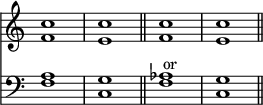of interruption leaves the mind unsatisfied and expecting something more should be called an Imperfect cadence. And this classification seems to include all the varieties. Every composer in writing feels that certain cadences are fitted for particular places in his work, and endeavours to give variety in his treatment of them. But it is unwise to give all these possible varieties definite titles, as what may answer the purpose of a full stop in one movement may only produce the effect of a semicolon in another, according to the calibre of the work.
The ideas at the root of the perfect cadence are two: first, that the key be emphatically defined; and secondly, that the expectation roused by the doubtful or discordant nature of one chord be absolutely satisfied by another.
The simplest and most perfect manner of obtaining these effects is the progression from dominant to tonic harmony, as in the example, which is the type of all perfect cadences.

Here the key is strongly marked by the number of notes proper to it which are employed, and also, as Helmholtz has pointed out, 'by the distinct passage from the remotest parts of the scale to the centre of the system' of the key, since the dominant chord contains the notes which are most remote in their relation to the tonic. On the other hand, the tonic chord in its first position is the only chord sufficiently decisive to be used as conclusion; and the dominant harmony must in any case be doubtful and inconclusive, even when concordant, and the effect is enhanced when, as in the example, a discord is made use of.
The common use of the major third in the tonic chord in the final cadences of pieces in a minor key is for the purpose above mentioned, of marking the key strongly, as the minor third is more obscure in character than the major third, and without the latter, especially in vocal music, the conclusion would not be so clear and incisive.
In old times, especially in church music, another very simple form of cadence was common; viz. that in which the penultimate chord is that of the sub-dominant or 4th of the key, either major or minor, as, in the key of C—

These two forms of the perfect cadence were distinguished as the Authentic and the Plagal, from the two main divisions of the ancient church modes. The latter is not so frequently used in modern music, except sometimes for variety, or to follow some particular turn of romance or sentiment which is expressed in the music.
The commonest form of Imperfect cadence is just a reversal of the dominant perfect cadence, so that the harmony of the dominant or 5th of the key is preceded by that of the tonic. In this case the effect will evidently not be conclusively satisfying, because a piece can only come to a complete stop on the harmony of the tonic. So, in the key of C, the cadence—

will leave the mind unsatisfied, though to a certain extent it produces the effect of a stop.
Another common form of imperfect cadence is that in which the harmony of the dominant is preceded by that of the supertonic, or 2nd note of the scale, direct or in inversion, thus—

as in Mozart's Quartet in G, No. 1—

and in Beethoven's Violin Sonata in G—

or the following from his Symphony in C minor—
![{ \override Score.TimeSignature #'stencil = ##f \override Score.Rest #'style = #'classical \time 2/4 \key c \minor << \relative g'' { r8 <g d g,>[ <g d g,> <f d g,>] | <ees c g>4 r | <c fis> r | << { g'2 } \\ { <b, g>4 r } >> | }
\new Staff { \clef bass \key c \minor \relative b, { r8 b[ b b] | c4 r | aes r | g r | } } >> }](http://upload.wikimedia.org/score/r/m/rmav0j0v6yx4w99ixc8nbtlx6i5ve22/rmav0j0v.png)
When a complete strain or subject is divided into two parts the first half frequently ends with an imperfect cadence, by which the continuity of the passage is not affected, though the division is sufficiently marked.
The imperfect cadence is also sometimes called a half close, which term has a good deal to recommend it as the fitter name of the two, both from its form and from the position it frequently occupies, as mentioned above.
The form of Interrupted cadence generally quoted as typical is that in which the chord of the dominant, instead of proceeding to the harmony of the tonic as the mind is led to

